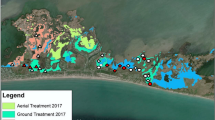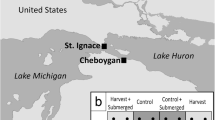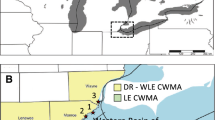Abstract
Invasive wetland plants are the primary targets of wetland management to promote native communities and wildlife habitat, but little is known about how commonly implemented restoration techniques influence nutrient cycling. We tested how experimental mowing, herbicide application, and biomass harvest (i.e., removal of aboveground biomass) treatments of Typha-invaded mesocosms altered porewater nutrient (NO3 −, NH4 +, PO −34 ) concentration and supply rate, vegetation response, and light penetration to the soil surface. We found that while herbicide application eliminated the target species, it also reduced native plant density and biomass, as well as increased porewater nutrient concentration (PO −34 , NO3 −) and supply rates (N, P, K) up to a year after treatments were implemented. Because herbicide application promotes nutrient enrichment, it may increase the likelihood of reinvasion by problematic wetland invaders, as well as cause eutrophication and deleterious algal blooms in adjacent aquatic systems. Our data suggest that biomass harvest should be considered by managers aiming to reduce Typha abundance without eradicating native diversity, avoid nutrient leaching, as well as possibly utilizing biomass for bioenergy.




Similar content being viewed by others
References
Anderson DM, Glibert PM, Burkholder JM (2002) Harmful algal blooms and eutrophication: nutrient sources, composition, and consequences. Estuaries 25:704–726
Apfelbaum S (1985) Cattail (Typha spp.) management. Nat Areas J 5:9–17
Boers AM, Zedler JB (2008) Stabilized water levels and Typha invasiveness. Wetlands 28:676–685
Boyd C (1970) Vascular aquatic plants for mineral nutrient removal from polluted waters. Econ Bot 24:95–103
Boyd M, Brown M, Brandt-Williams S (2015) Addressing pollutant load reduction goals for impaired waterbodies through biomass harvest of Phragmites australis (common reed). Wetl Ecol Manag. doi:10.1007/s11273-015-9406-6
Chen X-C, Kong H-N, He S-B, Wu D-Y, Li C-J, Huang X-C (2009) Reducing harmful algae in raw water by light-shading. Process Biochem 44:357–360
Cicek N, Lambert S, Venema H, Snelgrove K, Bibeau E, Grosshans R (2006) Nutrient removal and bio-energy production from Netley-Libau Marsh at Lake Winnipeg through annual biomass harvesting. Biomass Bioenergy 30:529–536
Conley DJ et al (2009) Controlling eutrophication: nitrogen and phosphorus. Science 323:1014–1015
Davis MA, Grime JP, Thompson K (2000) Fluctuating resources in plant communities: a general theory of invasibility. J Ecol 88:528–534
Farrer EC, Goldberg DE (2009) Litter drives ecosystem and plant community changes in cattail invasion. Ecol Appl 19:398–412
Farrer EC, Goldberg DE (2014) Mechanisms and reversibility of the effects of hybrid cattail on a Great Lakes marsh. Aquat Bot 116:35–43
Findlay S, Groffman P, Dye S (2003) Effects of Phragmites australis removal on marsh nutrient cycling. Wetl Ecol Manag 11:157–163
Freeland J, Ciotir C, Kirk H (2013) Regional differences in the abundance of native, introduced, and hybrid Typha spp. in northeastern North America influence wetland invasions. Biol Invasions 15:2651–2665
Frieswyk CB, Zedler JB (2006) Do seed banks confer resilience to coastal wetlands invaded by Typha × glauca? Can J Bot 84:1882–1893
Frieswyk CB, Zedler JB (2007) Vegetation change in great lakes coastal wetlands: deviation from the historical cycle. J Great Lakes Res 33:366–380
Gami B, Limbachiya R, Parmar R, Bhimani H, Patel B (2011) An evaluation of different non-woody and woody biomass of Gujarat, India for preparation of pellets—a solid biofuel. Energy Sources Part A 33:2078–2088
Hall SJ, Zedler JB (2010) Constraints on sedge meadow self-restoration in urban wetlands. Restor Ecol 18:671–680
Hall SJ, Lindig-Cisneros R, Zedler JB (2008) Does harvesting sustain plant diversity in central Mexican wetlands? Wetlands 28:776–792
Hansson P, Fredriksson H (2004) Use of summer harvested common reed (Phragmites australis) as nutrient source for organic crop production in Sweden. Agric Ecosyst Environ 102:365–375
Hazelton EL, Mozdzer TJ, Burdick DM, Kettenring KM, Whigham DF (2014) Phragmites australis management in the United States: 40 years of methods and outcomes. AoB Plants. doi:10.1093/aobpla/plu001
Herrman KS, Scott DT, Lenters JD, Istanbulluoglu E (2012) Nutrient loss following Phragmites australis removal in controlled soil mesocosms. Water Air Soil Pollut 223:3333–3344
Homan H, Linz G, Carlson R, Bleier W (2003) Spring distribution of ring-necked pheasants (Phasianus colchicus) following cattail reduction with glyphosate herbicide. Wildl Res 30:159–166
Hosoi Y, Kido Y, Miki M, Sumida M (1998) Field examination on reed growth, harvest and regeneration for nutrient removal. Water Sci Technol 38:351–359
Jordan T, Whigham D (1988) The importance of standing dead shoots of the narrow leaved cattail, Typha angustifolia L. Aquat Bot 29:319–328
Kercher SM, Zedler JB (2004) Multiple disturbances accelerate invasion of reed canary grass (Phalaris arundinacea L.) in a mesocosm study. Oecologia 138:455–464
Köbbing J, Thevs N, Zerbe S (2013) The utilisation of reed (Phragmites australis): a review. Mires Peat 13:1–14
Larkin DJ, Freyman MJ, Lishawa SC, Geddes P, Tuchman NC (2012a) Mechanisms of dominance by the invasive hybrid cattail Typha × glauca. Biol Invasions 14:65–77. doi:10.1007/s10530-011-0059-y
Larkin DJ, Lishawa SC, Tuchman NC (2012b) Appropriation of nitrogen by the invasive cattail Typha × glauca. Aquat Bot 100:62–66. doi:10.1016/j.aquabot.2012.03.001
Leitch J, Linz G, Baltezore J (1997) Economics of cattail (Typha spp.) control to reduce blackbird damage to sunflower. Agric Ecosyst Environ 65:141–149
Linz GM, Homan HJ (2011) Use of glyphosate for managing invasive cattail (Typha spp.) to disperse blackbird (Icteridae) roosts. Crop Prot 30:98–104
Lishawa SC, Albert DA, Tuchman NC (2010) Water level decline promotes Typha × glauca establishment and vegetation change in Great Lakes coastal wetlands. Wetlands 30:1085–1096
Lishawa SC, Jankowski KJ, Geddes P, Larkin DJ, Monks AM, Tuchman NC (2014) Denitrification in a Laurentian Great Lakes coastal wetland invaded by hybrid cattail (Typha × glauca). Aquat Sci 76:483–495
Lishawa SC, Lawrence BA, Albert DA, Tuchman NC (2015) Biomass harvest of invasive Typha promotes plant diversity in a Great Lakes coastal wetland. Restor Ecol. doi:10.1111/rec.12167
Manios T, Laux D, Manios V, Stentiford E (2003) Cattail plant biomass as a bulking agent in sewage sludge composting; Effect of the compost on plant growth. Compost Sci Util 11:210–219
Martin LJ, Blossey B (2013) The runaway weed: costs and failures of Phragmites australis management in the USA. Estuaries Coasts 36:626–632
Martin MR, Tipping PW, Reddy K, Daroub SH, Roberts KM (2010) Interactions of biological and herbicidal management of Melaleuca quinquenervia with fire: consequences for ecosystem services. Biol Control 54:307–315
Minchinton TE, Bertness MD (2003) Disturbance-mediated competition and the spread of Phragmites australis in a coastal marsh. Ecol Appl 13:1400–1416
Mitchell ME, Lishawa SC, Geddes P, Larkin DJ, Treering D, Tuchman NC (2011) Time-dependent impacts of cattail invasion in a Great Lakes coastal wetland complex. Wetlands 31:1143–1149
Murkin H, Ward P (1980) Early spring cutting to control cattail in a northern marsh. Wildl Soc Bull 8:254–256
Osland MJ, González E, Richardson CJ (2011) Restoring diversity after cattail expansion: disturbance, resilience, and seasonality in a tropical dry wetland. Ecol Appl 21:715–728
Pimentel D, Zuniga R, Morrison D (2005) Update on the environmental and economic costs associated with alien-invasive species in the United States. Ecol Econ 52:273–288
R Core Team (2014) R: a language and environment for statistical computing. Austria, Vienna
Rooth JE, Stevenson JC, Cornwall JC (2003) Increased sediment accretion rates following invasion by Phragmites australis: the role of litter. Estuaries 26:475–483
Rueppel ML, Brightwell BB, Schaefer J, Marvel JT (1977) Metabolism and degradation of glyphosate in soil and water. J Agric Food Chem 25:517–528
Ruiz M, Velasco J (2010) Nutrient bioaccumulation in Phragmites australis: management tool for reduction of pollution in the Mar Menor. Water Air Soil Pollut 205:173–185
Schindler DW et al (2008) Eutrophication of lakes cannot be controlled by reducing nitrogen input: results of a 37-year whole-ecosystem experiment. Proc Natl Acad Sci 105:11254–11258
Solberg KL, Higgins KF (1993) Effects of glyphosate herbicide on cattails, invertebrates, and waterfowl in South Dakota wetlands. Wildl Soc Bull 21:299–307
Tuchman N, Larkin D, Geddes P, Wildova R, Jankowski K, Goldberg D (2009) Patterns of environmental change associated with Typha × glauca invasion in a Great Lakes coastal wetland. Wetlands 29:964–975. doi:10.1672/08-71.1
Tulbure MG, Johnston CA, Auger DL (2007) Rapid invasion of a Great Lakes coastal wetland by non-native Phragmites australis and Typha. J Great Lakes Res 33:269–279
Vaccaro LE, Bedford BL, Johnston CA (2009) Litter accumulation promotes dominance of invasive species of cattails (Typha spp.) in Lake Ontario wetlands. Wetlands 29:1036–1048
Woo I, Zedler JB (2002) Can nutrients alone shift a sedge meadow towards dominance by the invasive Typha × glauca? Wetlands 22:509–521
Zedler J (2009) Feedbacks that might sustain natural, invaded and restored states in herbaceous wetlands. In: Hobbs RJ, Suding KN (eds) New models for ecosystem dynamics and restoration. Island Press, Washington, DC, pp 236–258
Zedler JB, Kercher S (2004) Causes and consequences of invasive plants in wetlands: opportunities, opportunists, and outcomes. Crit Rev Plant Sci 23:431–452
Acknowledgments
Many thanks to Jennifer Croskrey and Margaret Workman for assistance with nutrient analysis, and to Jesse Albert, Drew Monks, Erica Marcos, Nia Hurst, Kelsey Berke, and Brendan Carson for watering the mesocosms and assisting with data collection.
Funding
A portion of this project was supported by NSF (AGS-1262634) to Dave Karowe and Mary Anne Carroll, which provided Y. Rodriguez with an REU opportunity during the 2013 summer. Additionally, an EPA GLRI (GL-00E00545) award provided summer salary to B. Lawrence.
Author information
Authors and Affiliations
Corresponding author
Ethics declarations
Conflict of Interest
Lawrence has received research grants from the NSF and EPA. Lishawa has received research grants from the EPA and the Northern Trust Company Charitable Trust. Tuchman has received research grants from the EPA, USDA, DOE, NSF, NOAA, and the Northern Trust Company Charitable Trust. Tuchman is the director of The Institute of Environmental Sustainability (Loyola University Chicago), a member of the board of trustees for the Peggy Notebaert Nature Museum and the Delta Institute, and on the Environmental Law and Policy Center’s advisory board.
Rights and permissions
About this article
Cite this article
Lawrence, B.A., Lishawa, S.C., Rodriguez, Y. et al. Herbicide management of invasive cattail (Typha × glauca) increases porewater nutrient concentrations. Wetlands Ecol Manage 24, 457–467 (2016). https://doi.org/10.1007/s11273-015-9471-x
Received:
Accepted:
Published:
Issue Date:
DOI: https://doi.org/10.1007/s11273-015-9471-x




